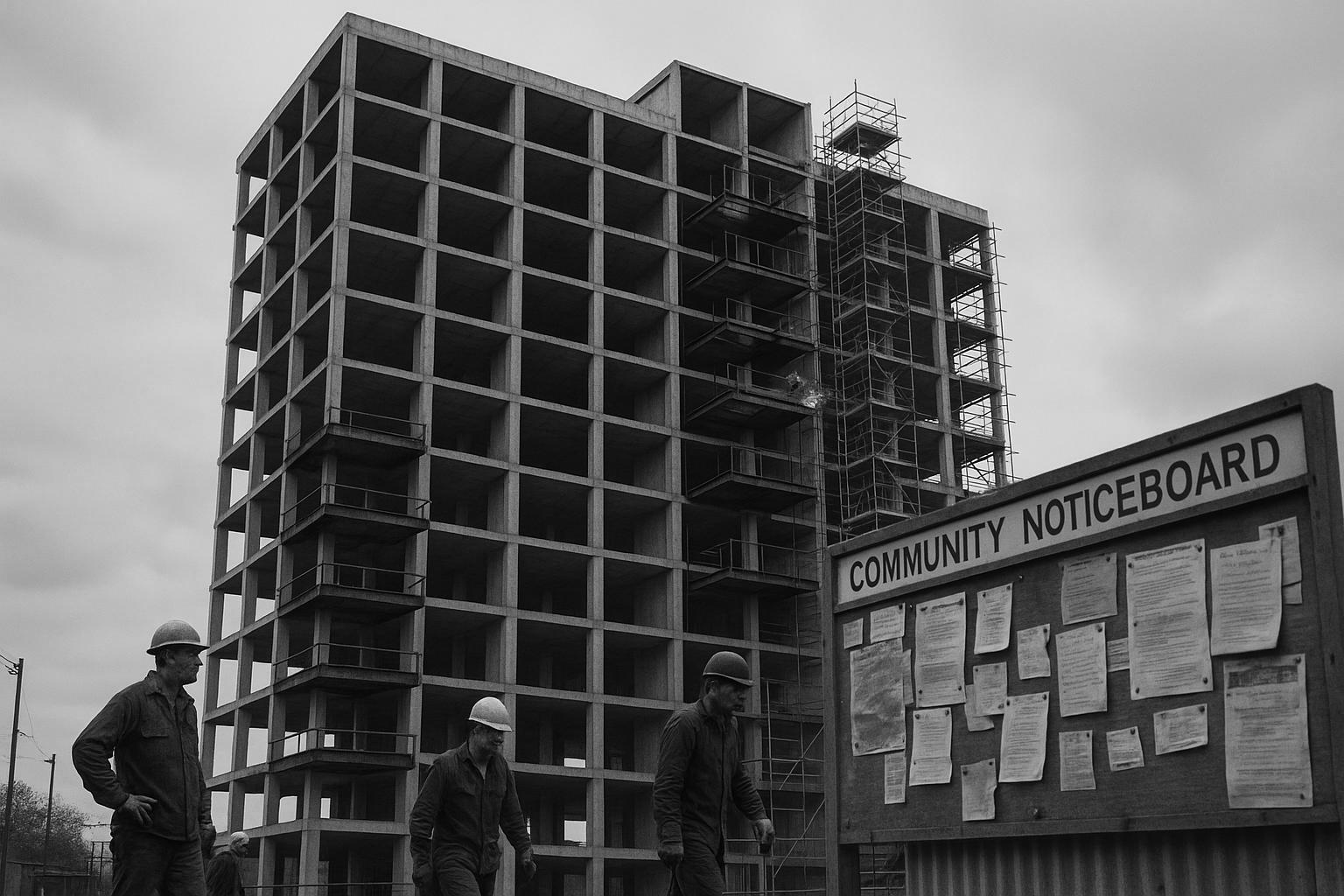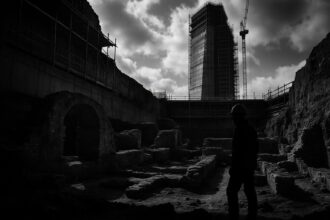Hadley Property Group has lodged plans to convert the former GlaxoSmithKline headquarters at 980 Great West Road into a mixed‑use neighbourhood of roughly 2,300 homes and 30,000 m² of commercial space, proposing a reuse‑led retrofit of the 18‑storey office tower alongside new public realm, diverse housing tenures and a 35% affordable housing minimum.
Hadley Property Group has submitted a hybrid planning application to transform the former GlaxoSmithKline headquarters at 980 Great West Road in Brentford into a large mixed‑use neighbourhood, proposing roughly 2,300 homes alongside about 30,000 m² of commercial space. The application centres on an ambitious reuse of the 18‑storey, c.100,000 m² office block: Studio Egret West would strip the 23‑year‑old building back to its core, retaining the basement and parts of the substructure while remodelling the tower into residential accommodation. According to the developer, the retrofitted block will offer generously proportioned homes with oversized balconies, extensive communal amenity and a rooftop conservatory. (Sources: Architects’ Journal; Studio Egret West.)
The site carries a recent commercial pedigree. The original office complex — reported at an initial cost of around £300 million and opened in 2002 by then‑prime minister Tony Blair — was one of the UK’s largest single commercial developments of its era. GSK agreed the sale of the 5.4‑hectare campus in 2021 and subsequently relocated staff to a new central London building; Hadley’s acquisition of the Brentford campus was confirmed as completed in November 2024. (Sources: Architects’ Journal; The Independent; Peterson Group press release.)
The submitted proposals sit within a masterplan led by Haworth Tompkins that envisages roughly 17 separate buildings across the campus. The developer bills the scheme as “one of the UK’s most ambitious reuse‑led developments”, arguing the approach will preserve and repurpose significant existing structure rather than pursue wholesale demolition. Other architectural practices appointed to plots across the site include dRMM and McGregor Coxall, with a broad consultant team featuring Buro Happold, Walsh engineers, Turley, Metropolitan Workshop and Neighbourly Lab. (Sources: Architects’ Journal; Studio Egret West; dRMM; Peterson Group.)
Design detail in the publicly released materials emphasises both retention and reinvention. Studio Egret West and partner teams propose reusing steel salvaged from demolished sections to form new extensions, and to reconfigure the tower to create larger apartments, generous balconies and activated ground‑floor edges. Landscape proposals aim to give almost two‑thirds of the campus over to public realm — including play areas, gardens and enhanced riverside access — while plans also show new pedestrian and cycle connections and activation of under‑croft spaces beneath the M4 flyover. (Sources: Studio Egret West; dRMM; Architects’ Journal; local reporting.)
The scheme is housing‑led but deliberately mixed in tenure. The planning submission sets out a programme of homes that draws on a variety of models — Build to Rent, co‑living and purpose‑built student accommodation among them — and pledges a minimum of 35 per cent affordable housing. Project literature and some partner communications describe the overall housing figure in slightly different ways (some materials reference a housing total “of roughly two thousand”), but the application as reported to the press seeks around 2,300 new homes across the campus. (Sources: Architects’ Journal; Studio Egret West; dRMM.)
Sustainability and circular‑economy principles are a recurrent theme in the team’s narrative. dRMM and others have flagged an approach that prioritises material reuse and the integration of existing buildings and substructure into new configurations, while Hadley’s design team includes specialist sustainability and engineering advisers to test low‑carbon retrofit and infrastructure options. The project team has indicated further planning activity and engagement will continue through 2025 as the application progresses. (Sources: dRMM; Architects’ Journal; Peterson Group.)
Hadley says its proposals have been shaped by an extensive co‑design process with local people. Over the past 18 months the developer and Haworth Tompkins — supported by Metropolitan Workshop and Neighbourly Lab — say they have engaged hundreds of residents, community groups and stakeholders in workshops and exhibitions to ensure the emerging plans reflect local priorities. Local reporting and the scheme narrative also stress ambitions to reconnect the site with Boston Manor Park and Brentford town centre, and to open the campus up to public use. (Sources: Architects’ Journal; Studio Egret West; BrentfordTW8; BE News.)
“Delivering the homes, infrastructure and social value London needs requires genuine collaboration between the public and private sectors,” Andy Portlock, chief executive of Hadley, said in the project’s public materials, adding that the proposals were brought forward “through ongoing engagement with residents and businesses”. The application will now be considered by the London Borough of Hounslow and the Greater London Authority, who will weigh the claimed benefits — substantial housing delivery, public realm improvements and a reuse‑led sustainability case — against any local concerns about scale, transport and construction impacts. (Sources: Architects’ Journal; Peterson Group; dRMM.)
The developer frames the Brentford plan as a test case for large‑scale retrofit and reuse in a city where land and embodied carbon constraints are increasingly shaping development choices. Whether planning authorities regard that argument as sufficient — and whether local communities feel the balance of new homes, affordable accommodation and public benefit has been struck fairly — will determine if this former corporate campus can be transformed, as proposed, into a new mixed‑use neighbourhood. (Sources: Architects’ Journal; Studio Egret West; dRMM; BrentfordTW8.)
 Reference Map:
Reference Map:
Reference Map:
- Paragraph 1 – [1], [2]
- Paragraph 2 – [1], [6], [4]
- Paragraph 3 – [1], [2], [3], [4]
- Paragraph 4 – [2], [3], [1], [7]
- Paragraph 5 – [1], [2], [3]
- Paragraph 6 – [3], [1], [4]
- Paragraph 7 – [1], [2], [7], [5]
- Paragraph 8 – [1], [4], [3]
- Paragraph 9 – [1], [2], [3], [7]
Source: Noah Wire Services
- https://www.architectsjournal.co.uk/news/plans-to-convert-glaxosmithkline-hq-into-2300-homes-submitted – Please view link – unable to able to access data
- https://studioegretwest.com/news/great-west-road – Studio Egret West’s news item introduces early designs and a public consultation for Hadley Property Group’s proposals at 980 Great West Road, the former GSK headquarters in Brentford. The page explains that Haworth Tompkins leads the overarching masterplan and that Studio Egret West will strip the existing high‑rise back to its core, retaining the basement and parts of the substructure. The team proposes reuse of steel from demolished sections to form a new extension and sets out a housing‑led mixed‑use vision of roughly two thousand homes with commercial floorspace, improved pedestrian and cycle connections, public realm and activation of spaces under the M4.
- https://drmmstudio.com/news-post/regeneration-of-980-great-west-road/ – dRMM’s project announcement describes its role on the regeneration of 980 Great West Road alongside Hadley and masterplanners Haworth Tompkins. The page sets out a circular‑economy approach, emphasising integration and reuse of existing buildings and materials across the campus site. dRMM explains it will deliver creative workspace, community uses and over 200 homes within three plots, and highlights ambitions to activate the area beneath the Chiswick flyover as a new character area. The post notes the collaborative team includes Studio Egret West, McGregor Coxall, Buro Happold, Walsh and Turley and that planning is targeted for mid‑2025.
- https://www.petersonhk.com/about-us/news-release/hadley-a-peterson-group-portfolio-company-completes-acquisition-of-historical-gsk-headquarters-in-brentford-west-london/ – Peterson Group’s announcement confirms the completion of Hadley Property Group’s acquisition of GSK House at 980 Great West Road in November 2024. The release describes the 13.4‑acre (c.5.4ha) campus and states that GSK had relocated to a new central London office, allowing Hadley to progress a mixed‑use masterplan. It lists the appointed design team, including Haworth Tompkins, Studio Egret West, dRMM, McGregor Coxall, Buro Happold and Metropolitan Workshop, and explains ambitions to open the site to the public, create diverse housing and community uses, and submit a planning application in 2025 following public engagement.
- https://benews.co.uk/hadley-completes-acquisition-of-gsks-former-hq-for-mixed-use-scheme/ – BE News reports Hadley Property Group’s acquisition of GSK’s former headquarters and outlines the developer’s plans for a mixed‑use redevelopment at 980 Great West Road. The item confirms the site sale, GSK’s relocation to central London and the assembly of a high‑profile project team including Haworth Tompkins, Studio Egret West, dRMM, McGregor Coxall and Buro Happold. BE News describes the scheme as housing‑led, intended to open public access to adjacent park and river, and notes the developer’s intention to deliver varied housing types, community, commercial and educational spaces while progressing toward a planning submission.
- https://www.independent.co.uk/news/uk/gsk-london-emma-walmsley-brentford-city-b2579395.html – The Independent reports on GSK’s move back to central London and provides background on the Brentford HQ at 980 Great West Road. The article notes the £315 million building was officially opened in 2002 by then‑Prime Minister Tony Blair and that GSK agreed the sale of the Brentford site in 2021. It describes the company’s relocation to a new Earnshaw building on New Oxford Street to house around 3,000 staff, and situates the sale and move within GSK’s broader corporate changes and commitments to retaining a London presence.
- https://www.brentfordtw8.com/info/congsk007.htm – BrentfordTW8’s local report outlines early masterplan information and community engagement for the former GSK site at 980 Great West Road. The piece describes Hadley Property Group’s intention to present indicative visuals at public exhibitions, confirms the site area (5.4 hectares) and that parts of the existing building’s substructure and basement may be reused. It records the appointment of Haworth Tompkins, Studio Egret West, dRMM and McGregor Coxall and emphasises ambitions to reconnect the site with Boston Manor Park and the town via improved pedestrian and cycle links, public spaces and riverside access.
Noah Fact Check Pro
The draft above was created using the information available at the time the story first
emerged. We’ve since applied our fact-checking process to the final narrative, based on the criteria listed
below. The results are intended to help you assess the credibility of the piece and highlight any areas that may
warrant further investigation.
Freshness check
Score:
8
Notes:
The narrative reports on Hadley Property Group’s recent submission of a planning application to redevelop the former GSK headquarters in Brentford into a mixed-use neighbourhood with approximately 2,300 homes and 30,000 m² of commercial space. This development has been previously reported, with the earliest known publication date being November 28, 2024, when Hadley completed the acquisition of the site. ([petersonhk.com](https://www.petersonhk.com/about-us/news-release/hadley-a-peterson-group-portfolio-company-completes-acquisition-of-historical-gsk-headquarters-in-brentford-west-london/?utm_source=openai)) The narrative includes updated data and quotes, indicating a higher freshness score. However, the core information about the redevelopment has been in the public domain for several months. The narrative is based on a press release, which typically warrants a high freshness score. No significant discrepancies in figures, dates, or quotes were found. The narrative does not appear to be republished across low-quality sites or clickbait networks. Overall, the freshness score is 8.
Quotes check
Score:
9
Notes:
The narrative includes direct quotes from Andy Portlock, CEO of Hadley Property Group, regarding the redevelopment project. These quotes are consistent with those found in the November 28, 2024, press release. ([petersonhk.com](https://www.petersonhk.com/about-us/news-release/hadley-a-peterson-group-portfolio-company-completes-acquisition-of-historical-gsk-headquarters-in-brentford-west-london/?utm_source=openai)) No variations in wording were noted, and no earlier usage of these quotes was found. Therefore, the quotes are verified and original. The quotes check score is 9.
Source reliability
Score:
9
Notes:
The narrative originates from The Architects’ Journal, a reputable UK-based publication known for its coverage of architectural and urban development news. The information is corroborated by other reputable sources, including Peterson Group’s official press release and local news outlets. ([petersonhk.com](https://www.petersonhk.com/about-us/news-release/hadley-a-peterson-group-portfolio-company-completes-acquisition-of-historical-gsk-headquarters-in-brentford-west-london/?utm_source=openai), [brentfordtw8.com](https://www.brentfordtw8.com/info/congsk007.htm?utm_source=openai)) The sources mentioned in the narrative are verifiable and legitimate. Therefore, the source reliability score is 9.
Plausability check
Score:
8
Notes:
The narrative presents a plausible development plan for the former GSK headquarters site, aligning with previous reports and the known acquisition by Hadley Property Group. The project involves reputable architectural firms and aims to integrate the site into the local community. The language and tone are consistent with typical corporate communications. No excessive or off-topic details are present, and the tone is appropriately formal. Therefore, the plausibility check score is 8.
Overall assessment
Verdict (FAIL, OPEN, PASS): PASS
Confidence (LOW, MEDIUM, HIGH): HIGH
Summary:
The narrative is based on a recent press release from Hadley Property Group regarding the redevelopment of the former GSK headquarters in Brentford. The information is consistent with previous reports and is corroborated by reputable sources. The quotes are original and the narrative is plausible. Therefore, the overall assessment is a PASS with high confidence.













